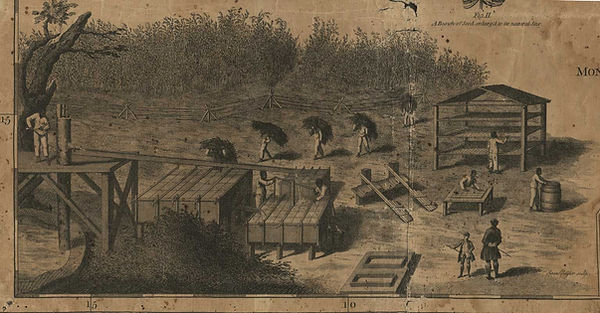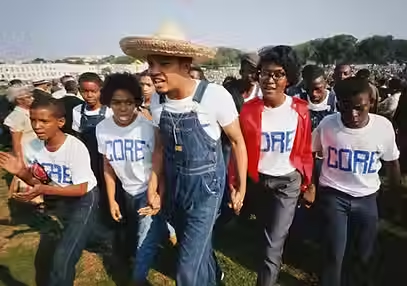DENIM NOSTALGIA
a quick history of denim & jeans
The journey of denim begins with practical necessity. In the late 17th century, Italian textile workers in Genoa were already producing a robust, hard-wearing fabric called 'jeane' (named after their city). Highly popular among the working class, particularly sailors, this fabric was transformed into all sorts of durable workwear, from trousers to overcoats.
Meanwhile, across the Alps in Nimes, France, weavers accidentally made the first modern denim. While aiming to produce "serge," another popular fabric of the time, they developed a sturdy, durable cotton twill that they called "serge de Nimes" – literally "twill from Nimes." Over time, as its versatility became widely recognized, the name was shortened to “denim."

late 17th century


mid 19th century
In America, "jean" fabric was widely adopted, often in block colors of indigo, olive, or brown. Denim, spun from white and indigo yarn, became the exclusive choice in workwear for miners, mechanics, cowboys, and farmers who demanded the most durable materials for their labor.
The story of indigo, the dye that gives denim its signature blue, is deeply intertwined with the history of the transatlantic slave trade. The cultivation of indigo in plantations across the South of the Americas during this period was dependent on the forced labor of enslaved Africans, and their uncredited labor was instrumental in establishing and maintaining this industry.
Denim. More than just a fabric; a living canvas of history, culture, and social change.From its humble origins as durable workwear to its iconic status in fashion and rebellion, denim's story is woven with threads from diverse communities and movements, reflecting the dynamic interplay of utility, identity, and cultural expression.

Indigo in the Fabric of Early South Carolina, Charleston County Public Library
In 1848, Levi Strauss emigrated to the US from Bavaria & began working with his brothers in New York. He later moved to
San Francisco to open a store selling many products including buttons, threads, canvas for tents and denim.



1848
1853
Denim became very popular during the Californian Gold Rush in 1853. Strauss began making durable pants for miners who needed pants that could withstand months of heavy wear with big pockets for storing gold. It was the right place, the right time. The denim pants were a hit.



Miners in jeans, Getty Images

1873
One of his customers was Jacob Davis, a tailor commissioned by a gold mining company, who improved the strength of the jeans even further by reinforcing stress points with metal rivets. After years of successful business, in 1873, they officially became partners, got the design patent, and modern American denim blue jean was born.
20th century
With the expiration of Strauss and Davis’s patent in 1890, other manufacturers entered the market, including OshKosh B’Gosh (1895), Blue Bell (later Wrangler) (1904), and Lee (1911).




1920s
By the 1920s, jeans became a wardrobe staple in the American West for the working class – cowboys, lumberjacks, and railroad workers.

From The 501® Jean: Stories of an Original, Full Documentary
It’s thought that Levi’s jeans were first introduced to the East during the dude ranch craze of the 1930s. Fashion magazine Vogue gave their seal of approval, calling jeans “Western chic”.
1930s



1940s

A new chapter unfolded during World War II in 1940s. The American GIs brought their denim pants with them overseas.
Nothing new was being produced due to raw material shortages, so they were limited in number, yet demand soared. The end of the war marked a change in how they were perceived - jeans were now less associated with workwear and more with leisure wear.

The 1950s witnessed denim's explosion in American culture. Hollywood icons like James Dean, Marlon Brando, and Marilyn Monroe popularized denim on the silver screen, while rock 'n' roll stars owning the style fueled the fever. Films such as Rebel Without a Cause, The Wild One, and The Misfits cemented denim's image as cool, defiant, and rebellious. This association led to denim being banned from some schools, theaters, and restaurants, ironically fueling its allure as a symbol of non-conformity. Jeans became so synonymous with freedom during the Cold War that Soviet smuggling of American denim was practically a punchline, underscoring its global symbolic power.
1950s




James Dean, Rex Features
Brigitte Bardot, Getty
Marlon Brando, The Wild Ones
1960s & 1970s
As rebelliousness became a defining theme for youth, denim took on new symbolic weight. The counterculture movement, including hippies and anti-war protestors wore jeans as a powerful statement of solidarity with the working class. Post-war hippies and the golden age of disco also popularized the dramatic flair of bootcut flares. Simultaneously, feminists and women's rights organizers utilized blue jeans as a tool to champion gender equity, challenging traditional norms of dress and asserting equality.
Blaxploitation films like SuperFly and Foxy Brown propelled denim styling forward with brash, over-the-top silhouettes and embellishments. In this film culture, denim continued to serve as the voice of the youth and revolutionary ideology, becoming more stylized and a vibrant part of Black cultural expression.


From The 501® Jean: Stories of an Original, Full Documentary

Credit: Corbis via Getty Images
late 1970s & early 1980s
By the late 1970s and early 1980s, high fashion began to take serious notice of denim. Fiorucci’s Buffalo 70 jeans were skin-tight, dark, expensive, and hard to buy – the opposite of all the things denim signified for the younger crowd. Calvin Klein broke ground by being the first designer to feature blue jeans on the runway in 1976.
The 1980s redefined denim with a new kind of seduction, famously seen in Brooke Shields’s provocative Calvin Klein campaign and Claudia Schiffer’s ads for Guess.
In November 1983, Yves Saint Laurent told New York Magazine “I have often said that I wish I had invented blue jeans. They have expression, modesty, sex appeal, simplicity — all that I hope for in my clothes.”


A Calvin Klein show in 1976 Rex Features
Fiorucci
From The 501® Jean: Stories of an Original, Full Documentary
The 1980s also marked the rising influence of Hip-Hop, Rap, and R&B artists on denim culture. This era saw the emergence of a distinctive street style that shaped trends for decades to come. Pioneering groups like Funky Four Plus 1 often wore head-to-toe denim, paving the way for artists to integrate denim into their signature looks, infusing it with urban cool and individuality. While high fashion made its overtures, the streets were defining a new, authentic denim aesthetic.
By 1990s, fashion houses such as Versace, Dolce & Gabbana and Dior had entered the market. This decade, characterized by the spirit of freedom, ushered another era in denim culture with new trends such as baggy jeans and dungarees, as well as a resurgence of the boot cut silhouette. Celebrities including Spice Girls & Destiny’s Child helped popularize these looks globally.


1990s
Spice Girls
Destiny's Child - No, No, No Part 2 Official Music Video ft. Wyclef Jean
Black artists and designers profoundly amplified denim's presence in mainstream culture. Hip-Hop artists frequently showcased oversized denim, creating a silhouette that became synonymous with the genre. Brands like Cross Colours (founded in 1989), revolutionary for using vibrant colors and bold graphics on denim with positive messages about Black pride and unity, and Ecko Unltd. (founded in 1993), emerged, creating clothing "for the streets, by the streets."


2000s

In 2000s, DIY jeans were officially in - customized denim became a hot trend as it enabled wearers to express themselves creatively through their style, a key part of the Millennial mindset. High-rise styles largely gave way to ultra-skinny, low-rise models, famously championed by icons like J.Lo, Britney Spears, Paris Hilton, and Nicole Richie.

Paris Hilton, Getty
Jennifer Lopez
Britney Spears & Justin Timberlake Iconic Red Carpet Look,
2001 American Music Awards
This decade continued to see the significant influence of music on denim. Pharrell notably bridged the gap between skaters and rap fans with his signature style and slimmer-fitting jeans. Brands like Apple Bottom Jeans (co-founded by Nelly in 2003) became incredibly popular, catering directly to the aesthetics and demands of urban youth. These looks solidified denim's place as a cornerstone of street style, pushing boundaries with washes, finishes, and fits that resonated deeply with diverse communities.
The 2010s saw environmental sustainability become a crucial part of the denim conversation. "Raw denim" was reintroduced at a mass level, with brands like Nudie Jeans, A.P.C., and Iron Heart catering to casual denimheads and blue-blooded aficionados alike. Utility and workwear influences re-emerged as major trends, and attributes like value, price, and comfort became increasingly demanded by consumers.
While most mass-market fashion brands now offered their denim ranges, Levi's, Wrangler, and Lee remained iconic household names, testament to their enduring legacy.
2010s


today & future of denim
Today and in the future, denim continues to mirror – and often lead – fashion's growing focus on social and environmental sustainable production.
We're seeing the rise of new development models such as made-to-order and digital clothing, alongside a burgeoning interest in vintage and second-hand markets. This is accompanied by an increasing interest towards transparency as well as an understanding towards materials, responsible production methods, repair models, both big-scale initiatives led by brands and conscious consumerism. Denim is also modernizing sportswear and athleisure, while we also saw that the recent global pandemic introduced a demand and possibility for softer, more comfortable, almost PJ-like denim loungewear made with lightweight fabrics.
Witnessing what a versatile fabric it is and how it has evolved over the years with culture, art, and protest, denim will undoubtedly remain the fabric of tomorrow. Its ongoing story will continue to be written by diverse voices, reflecting its global and multifaceted significance.
Disclaimer:
as denim lovers enthusiastic about sharing transparent information about the industry, we prepared this page as an archive of the past for inspirational purposes only with no commercial goals. the imagery, videos and the content used were sourced from public domains. if you own any of them and would like to change / alter anything, please contact us at communications@future.possibilities.com at any time.
